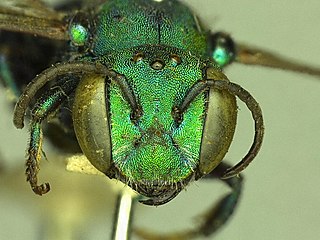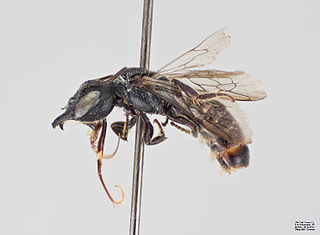
Megachilidae is a cosmopolitan family of mostly solitary bees. Characteristic traits of this family are the restriction of their pollen-carrying structure to the ventral surface of the abdomen, and their typically elongated labrum. Megachilid genera are most commonly known as mason bees and leafcutter bees, reflecting the materials from which they build their nest cells ; a few collect plant or animal hairs and fibers, and are called carder bees, while others use plant resins in nest construction and are correspondingly called resin bees. All species feed on nectar and pollen, but a few are kleptoparasites, feeding on pollen collected by other megachilid bees. Parasitic species do not possess scopae. The motion of Megachilidae in the reproductive structures of flowers is energetic and swimming-like; this agitation releases large amounts of pollen.

Mason bee is a name now commonly used for species of bees in the genus Osmia, of the family Megachilidae. Mason bees are named for their habit of using mud or other "masonry" products in constructing their nests, which are made in naturally occurring gaps such as between cracks in stones or other small dark cavities. When available, some species preferentially use hollow stems or holes in wood made by wood-boring insects.

Osmia cornifrons, also known as the horned-face bee, is a species of solitary bee indigenous to Northern Asia. Physically, this species of bee is recognized for its horn-like extensions originating from its lower face. Populations of O. cornifrons have been recorded in multiple locations, including Japan, Korea, China, and Russia. O. cornifrons are more docile as compared to other species of bees and are less prone to sting when aggravated.

Osmia bicornis is a species of mason bee, and is known as the red mason bee due to its covering of dense gingery hair. It is a solitary bee that nests in holes or stems and is polylectic, meaning it forages pollen from various different flowering plants. These bees can be seen aggregating together and nests in preexisting hollows, choosing not to excavate their own. These bees are not aggressive; they will only sting if handled very roughly and are safe to be closely observed by children. Females only mate once, usually with closely related males. Further, females can determine the sex ratio of their offspring based on their body size, where larger females will invest more in diploid females eggs than small bees. These bees also have trichromatic colour vision and are important pollinators in agriculture.

Osmia latreillei is a species of mason bee belonging to the family Megachilidae subfamily Megachilinae.

Anthidiini is a tribe of insects in the family Megachilidae. There are at least 40 genera and 840 described species in Anthidiini. There is strong evidence that the tribe is monophyletic.

Dianthidium is a genus of leafcutter, mason, and resin bees in the family Megachilidae. There are at least 20 described species in Dianthidium.

Osmia foxi is a species of mason bees in the family Megachilidae. It is found in New Mexico and southeastern Arizona in the United States and in Sonora, Mexico.

Osmiini is a tribe of leafcutter, mason, and resin bees in the family Megachilidae. There are about 19 genera and at least 1,000 described species in Osmiini.

Osmia montana is a species of hymenopteran in the family Megachilidae. It is found in North America.

Protosmia is a genus of subgenus Chelostomopsis in the family Megachilidae. There are more than 30 described species in Protosmia.

Osmia calaminthae, commonly known as the blue calamintha bee, is a rare species of mason bee known only from two small areas in Florida, United States. It is considered Critically Imperiled by NatureServe. The common name for the bee is derived from its distinctly blue color and its favored host plant, Calamintha ashei.
Osmia sanrafaelae is a megachilid bee first identified in Utah's San Rafael Desert. The species' range is limited to the American intermountain West. O. sanrafaelae is a solitary nester that inhabits a wide range of ecosystems: pinyon-juniper scrubland, washes, sand dunes, and desert flatlands.

Osmia nigriventris, also known as the large black-bellied mason bee, is a species of solitary bee within the family Megachilidae.
Osmia adae is a species of bees within the genus Osmia, also known as mason bees, in the Megachilidae family.
Osmia lanei is a species of bee belonging to the genus Osmia and the family Megachilidae. They are native to northern California. Like all mason bees, it is solitary and does not work in massive hives. The species was first described in 1939 by Grace A. Sandhouse.
Osmia aeruginosa is a species of bee in the family Megachilidae and the genus Osmia. it is found in northern Fars province of iran
Osmia alaiensis is a species of bee in the family Megachilidae. It was described by Van der Zanden in 1994.

Osmia albiventris, also known has the white-bellied mason bee, is a species of bee native to Canada. It belongs to the genus Osmia and the family Megachilidae. Like most Osmia bees it is a solitary bee.

Osmia albolateralis is a species of bee that lives across the US. Mainly in the east, but also in British Columbia. Alberta. and Quebec it belongs to the genus Osmia and the family Megachilidae. It was described by Cockerell in 1906.














